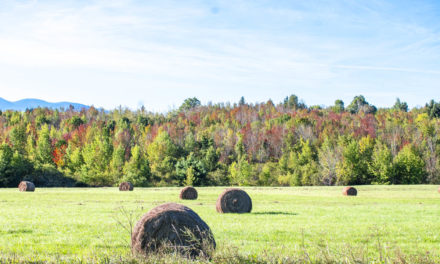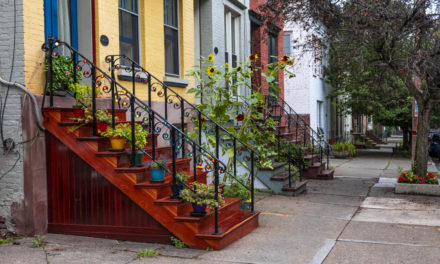Is there anything more symbolic of the beautiful, fleeting days of summer than a small butterfly fluttering carefree between colorful flowers?
And when thinking of our region, there is a particular butterfly that comes to mind: the Karner blue.
The blue butterflies were placed on the endangered species list in New York in 1977 and on the U.S. list in 1992. If you’ve ever wondered about the prescribed fires set at the Albany Pine Bush Preserve, they are intended in part to mimic natural wildfires that would restore and maintain the habitat suitable for wild blue lupine plants – the primary food for Karner caterpillars.
According to statistics from the past two seasonal brood populations, these conservation efforts seem to be working. The summer brood, seen in July and part of August, was as high as 18,000 in 2015 – a sharp increase from numbers well below 2,000 butterflies prior to 2011.
The Karner blue was first identified and named by Lolita author Vladimir Nabokov, a Russian-American novelist and lepidopterist (someone who studies or collects butterflies and moths for those of us who might not be science nerds).
“The connection between Vladimir Nabokov and butterflies is a really interesting one,” said Erin Kinal, the education program director at the Albany Pine Bush Preserve Commission.
She explained that Nabokov worked in entomology at the American Museum of Natural History and also at Harvard’s Museum of Comparative Zoology. He drew detailed scientific illustrations of Karners – named after the hamlet of Karner in the town of Colonie.
The butterflies (barely the size of the tops of your fingers) are also found in similar barrens in Michigan, Minnesota, New Hampshire, and Wisconsin.
With approximately 20 miles of multiple-use trails, the Albany Pine Bush Preserve is located in an inland pine scrub oak barrens similar to those found in New Jersey and Cape Cod, MA and on Long Island. There are less than 20 examples of this habitat in the world. (The WORLD).
Life of a Karner Blue
“Fleeting” is, sadly, a good description of summer days in the Northeast. It’s also an apt word to describe the extremely short adult life of a Karner blue. The adult butterflies live for just three to five days. They drink nectar from a variety of flowers, mate, lay eggs, and that’s about it.
You may dimly recall from those life cycle projects you (or your kids) worked on in school that milkweed provides food for Monarch butterflies. Karner blues have a similar relationship with wild blue lupine plants. They lay their eggs on the plants, and the larvae, once they hatch, eat leaves of wild blue lupine for three to four weeks.
The larvae are very picky eaters. They eat wild blue lupine leaves, period. The pupae themselves start out green – helping provide camouflage from predators – and gradually turn dark blue over a period of eight to 11 days. Soon, the cycle is complete, an adult butterfly emerges, and the circle of life begins all over again.
There is a spring and summer brood of Karner blue butterflies. The first brood of the year is usually in June and is a smaller population of butterflies. The larger brood occurs in the middle of summer, when the adults lay eggs that lie dormant over the fall and winter until larvae emerge again in the spring.
Unlike Monarchs, Karner blues do not migrate and seldom travel further than 700 feet during their short lifetimes.
Climate Change Challenges
Like more or less everything in nature, there are some concerns regarding climate change and its potential impacts on the Karner blue lifecycle.
The degree of the problem is being evaluated by a team of academic, state and federal agency scientists, working with the University of Notre Dame, as part of the U.S. Fish and Wildlife Service Federal Karner Blue Butterfly Recovery Team, according to Neil Gifford, conservation director at the preserve commission and a Recovery Team member.
“While understanding long-term implications of climate change on a single species in a single place is complicated, the existing data and analysis suggest that climate change will continue to threaten Karners with extinction throughout most of their current range,” Gifford said.
“Nationally, regionally and locally, climate data show that all seasons, but especially winter, are already getting warmer; the data and analysis also show that we, in Albany, are getting more precipitation.”
The good news, Gifford said, is that the team anticipates larger populations of Karner blue butterflies spread across more acres of habitat might insulate the population from possible climate change effects.
“Since 1996, we have restored more than 600 acres of Karner habitat in the preserve and seen the Karner population grow from fewer than 1,000 to more than 10,000 butterflies annually,” Gifford said.
Spotting a Karner Blue
An ideal setting to see the Karner blue would be an early, sunny morning during the summer brood of July or early August. The gardens of the Albany Pine Bush Discovery Center have multiple patches of wild blue lupine, and are among the best spots to find the butterflies.
The blue trail behind the Discovery Center is another location, said Wendy Craney, the communications and outreach director at the preserve commission.
Another prime spot to see the butterflies is the new Truax Tavern Barrens trailhead on Kings Road (the trailhead is about 1/8 mile down after the three-way stop signs for Kings Road when coming from the Discovery Center), said preserve commission executive director Chris Hawver.
While male butterflies are light blue, females are a darker color blue with orange crescents on the outer edge of the hind wings.
IF YOU GO
Albany Pine Bush Preserve’s Discovery Center is located off of Rt 155 at 195 New Karner Road, Albany.
Hours: The Discovery Center is open Monday thru Friday, 9am-4pm and Saturday & Sunday and most holidays 10am-4pm. The preserve trails are open all year, 24/7. There is no admission fee to use the trails or visit the Discovery Center.
List of events and programs: http://www.albanypinebush.org/
Photo courtesy of the Albany Pine Bush Preserve Commission.


